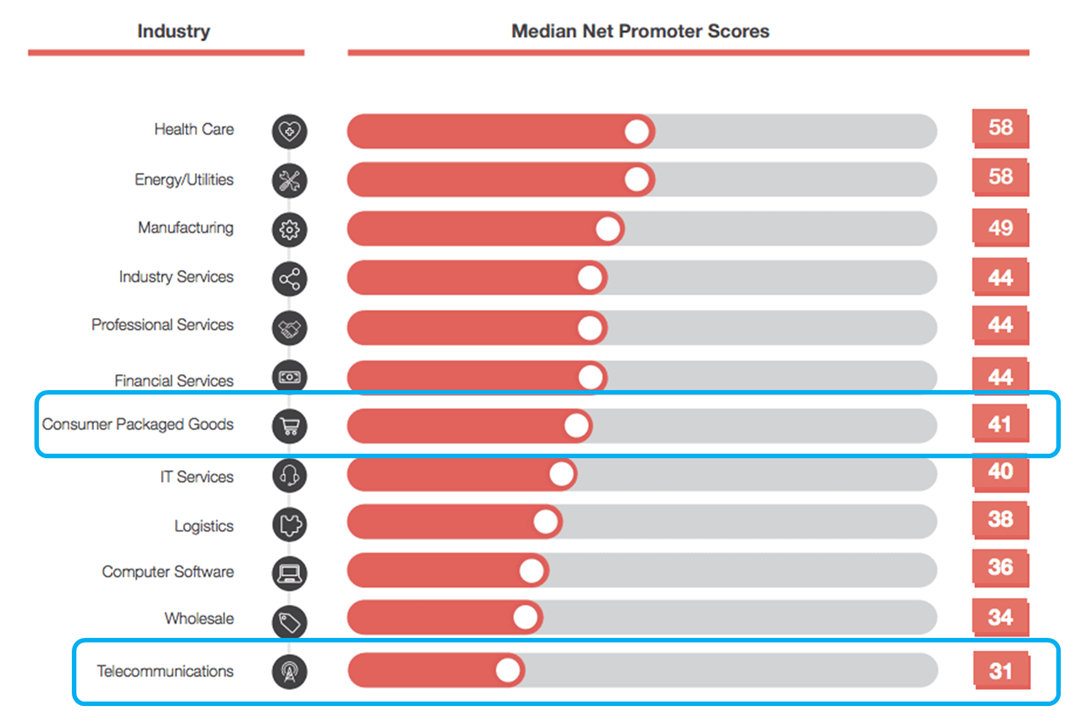There’s a concept in the packaging industry known as wrap rage. According to Wikipedia, it’s “the common name for heightened levels of anger and frustration resulting from the inability to open packaging.”
We in the telecommunications industry don’t have a similar term. However, the industry does have a history of causing customer rage, as partly indicated by consistently underperforming on Net Promoter Scores (NPS). Moreover, “In 2021, there were over 300 million wireless carrier subscribers in the U.S. With an industry churn rate of 22 percent, that gives us 95 million frustrated customers taking their interests—and wallet—to another provider.” (source)
NPS Score in the telco compared to other industries
The chart below shows that even the industry most associated with wrap rage, Consumer Packaged Goods (CPG), has a 28% better NPS than the telecommunications industry.

Source: customergauge.com
Of course, wrapping alone doesn’t drive the NPS score of the CPG industry. However, it is clearly one important piece. From a similar perspective, OSS/BSS (the “packaging” for the telecommunications industry) isn’t the sole contributor to the low NPS scores of the telecommunications industry, but it is an equally important component.
OSS/BSS solutions in telecom and their impact on churn
It might not be as apparent to the end-user that OSS solutions and BSS are the source of anger in the same way that poorly designed packaging is, but they are undoubtedly a primary source of “wrap rage” in the telecommunications industry. Whilst customers might not have a name for their frustration, a churn rate of 22% clearly indicates its existence.
Despite this, most suppliers and integrators in the OSS and BSS industry are oblivious to their impact on this frustration. They’re one step removed from NPS scores. They’re also typically one step removed from the front lines, the retail shops, the IT access points (portals and apps) and contact centres.
Their involvement with the front lines is usually only as a customer that uses telco services, not through their work activities. If you’re reading this and are responsible for designing, implementing or building OSS and/or BSS, do you like having to contact your communications service provider? Regardless of whether your answer is yes or no, have you ever thought that the work you do is contributing to that sentiment?
How to achieve CVR? Make your customers have nothing to complain about
Contact centre teams have a term called Call Volume Reduction (CVR), which means the number of customer calls that are answered by a contact centre agent. CVR is a metric that all organisations aim to minimise because having contact centre and support teams is costly. Carriers would much rather not have these business units. Rather than achieving CVR by deflection (eg redirecting customers to digital services like IVRs, chat-bots, webpages, etc), which tend to infuriate upset customers further, the simplest approach to achieving CVR is to ensure there are less issues for customers to complain about.
The takeaway
Afterall, the best customer service is no customer service. That is, the best service is so seamless that nobody has any reason to complain.
Reducing faults, making self-service changes easier, reducing activation fall-outs, reducing bill disputes and many other high-volume issues are all within the control and responsibility of OSS and BSS. Is it now becoming clearer that what we do has a direct impact on the graph above?
Rather than adding new OSS and BSS features, it could be argued that the better return on developer / integrator / implementation effort would be to improve existing functionality to reduce end-user complaints and improve CVR. If you work for an OSS / BSS vendor, have you ever asked your carrier clients whether you could do anything to improve their CVR?